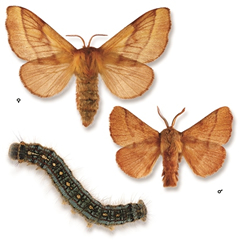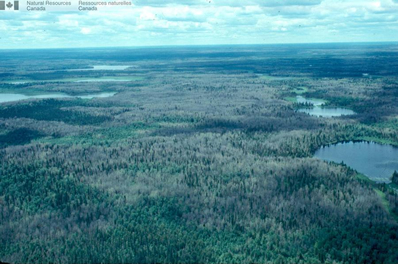The forest tent caterpillar (Malacosoma disstria) is native to North America. It is one of three tent caterpillar species, which also include the eastern tent caterpillar (Malacosoma americanum) and the western tent caterpillar (Malacosoma californicum pluviale).
The forest tent caterpillar attacks trembling aspen, oak, ash, maple and white birch.
It has several natural predators such as ants, birds, vespid or yellowjacket wasps and parasitic wasps.
Quick facts
- The forest tent caterpillar can cause serious damage through the widespread eating of leaves and shoots.
- Trees weaken by repeated defoliation and can be more vulnerable to various stresses, such as drought or infestation by other insects.
- Forest tent caterpillar outbreaks are an expected part of boreal forest ecology and are considered a natural disturbance, just like fire.
- Widespread outbreaks have been recorded in much of the boreal forest since the 1930s.
- The forest tent caterpillars defoliated 4.8 million hectares of Canadian forest in 2015.
- Large outbreaks among aspen trees have been recorded in Alberta, Ontario and Quebec.

Forest tent caterpillar (top: adult male moth; right: adult female moth; bottom: caterpillar).
Impacts
Damage caused by forest tent caterpillar infestations may have different impacts.
- The decline of hardwoods can harm the timber supply.
- If climate change influences future outbreaks, the health of the boreal forest may be affected, with serious environmental and economic consequences.

Aerial view of damage caused by the forest tent caterpillar.
CFS scientific research
Research conducted by scientists at the Canadian Forest Service (CFS) has led to a number of insights into the forest tent caterpillar.
- Infestations happen in cycles of every 10-12 years and can last up to 3 to 6 years.
- The end of an outbreak is associated with an increase in disease (typically viruses) in the population.
- There seems to be synchronization among outbreaks in different areas within Ontario and Quebec.
This research helps resource managers develop effective pest management strategies.
Working collaboratively to develop solutions
Through the Canadian Forest Service, Natural Resources Canada collaborates with provincial governments in Alberta, Saskatchewan, Ontario and Quebec as well as university partners, including the University of Alberta, MacEwan University and Concordia University, researching how the growth of an outbreak is affected by young larvae mortality and how the stage of an outbreak impacts moth flight patterns.
Under the National Forest Pest Strategy, scientific research is designing the best approaches to managing the forest tent caterpillar at all jurisdictional levels. This information will be used to predict the influence of climate change on outbreaks and the effects of insect outbreaks on carbon budget estimates.
Provincial governments continue to monitor for signs of forest tent caterpillar population outbreaks. The overall health of the different tree species that are affected by the forest tent caterpillar is a major concern.
Want more information on the forest tent caterpillar?
Contact Chris MacQuarrie of the Great Lakes Forest Centre.
- Top forest insects and diseases in Canada
- Trees, insects and diseases of Canada’s forests
- Trees, insects and diseases of Canada’s forests - Lymantria dispar
- Understanding patterns in forest tent caterpillar outbreaks: Developing effective pest management strategies. (2013)
- Trembling aspen responses to drought and defoliation by forest tent caterpillar and reconstruction of recent outbreaks in Ontario (2007)
- More CFS publications on the forest tent caterpillar
- Health Canada - Gypsy moths